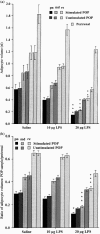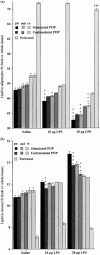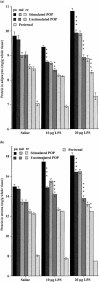The cellular structure and lipid/protein composition of adipose tissue surrounding chronically stimulated lymph nodes in rats
- PMID: 12846476
- PMCID: PMC1571111
- DOI: 10.1046/j.1469-7580.2003.00188.x
The cellular structure and lipid/protein composition of adipose tissue surrounding chronically stimulated lymph nodes in rats
Abstract
To test the hypothesis that chronic immune stimulation of a peripheral lymph node induces the formation of additional mature adipocytes in adjacent adipose tissue, one popliteal lymph node of large male rats was stimulated by local injection of 10 microg or 20 microg lipopolysaccharide three times a week for 6 weeks. Adipocyte volumes in sites defined by their anatomical relations to the stimulated and homologous unstimulated popliteal lymph nodes were measured, plus adipocyte complement of the popliteal depot, and the lipid and protein content of adipocytes and adipose stroma. The higher dose of lipopolysaccharide doubled the mass of the locally stimulated lymph node and the surrounding adipose tissue enlarged by the appearance of additional mature adipocytes. Similar but smaller changes were observed in the popliteal adipose depot of the unstimulated leg and in a nodeless depot. The lipid content of the adipocytes decreased and that of the stroma increased dose-dependently in all samples measured but the changes were consistently greater in the depot surrounding the stimulated lymph node. The protein content of both adipocytes and stroma increased in samples surrounding the stimulated node. We conclude that chronic immune stimulation of lymphoid tissues induces the formation of more adipocytes in the adjacent adipose tissue. These findings suggest a mechanism for the selective hypertrophy of lymphoid-containing adipose depots in the HIV-associated adipose redistribution syndrome.
Figures




References
-
- Amri E-Z, Ailhaud G, Grimaldi P-A. Fatty acids as signal transducing molecules: involvement in the differentiation of preadipose to adipose cells. J. Lipid. Res. 1994;35:930–937. - PubMed
-
- Björntorp P. The regulation of adipose-tissue distribution in humans. Int. J. Obesity. 1996;20:291–302. - PubMed
-
- Bradford MM. A rapid and sensitive method for the quantitation of microgram quantities of protein utilizing the principle of protein-dye binding. Ann. Biochem. 1976;72:248–254. - PubMed
-
- Carr A. HIV protease inhibitor–related lipodystrophy syndrome. Clin. Infect. Dis. 2000;30:S135–S142. - PubMed
-
- Coppack SW. Pro-inflammatory cytokines and adipose tissue. Proc. Nutr. Soc. 2001;60:349–356. - PubMed
Publication types
MeSH terms
Substances
LinkOut - more resources
Full Text Sources

